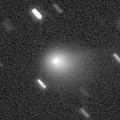
|
Now it is so bright as 9.8 mag (Sept. 13, Juan Jose Gonzalez). Getting lower graudally in the evening sky. It will be unobservable in late September in the Southern Hemisphere, or in mid October in the Northern Hemisphere. In the Southern Hemisphere, it will appear in the morning sky at 9 mag in 2013 February, then it keeps observable in good condition while fading slowly. In the Northern Hemisphere, it is hardly observable after 2013.
Date(TT) R.A. (2000) Decl. Delta r Elong. m1 Best Time(A, h)
Sept.22 15 2.40 9 27.4 2.828 2.265 46 10.2 19:20 (112, 14)
Sept.29 15 12.02 6 28.5 2.836 2.216 43 10.1 19:26 (106, 11)
|
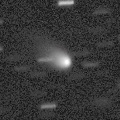
|
It is expected to be a great comet of -1 mag in 2013 spring. Now it is 11.6 mag (Sept. 15, Jakub Cerny). Brightening faster than originally expected. In 2012, it keeps observable until October in the Southern Hemisphere. In the Northern Hemisphere, it will be unobservable soon. Then it keeps unobservable for a long time until 2013 March, when the comet will appear as a 0-mag great comet. By the way, Juan Jose Gonzalez reported it extremely bright as 9.5 mag visually on Aug. 21.
Date(TT) R.A. (2000) Decl. Delta r Elong. m1 Best Time(A, h)
Sept.22 15 6.63 -26 25.7 3.594 3.093 52 11.7 19:20 ( 80, 34)
Sept.29 15 10.35 -26 53.9 3.591 3.000 47 11.5 19:26 ( 76, 29)
|

|
Now it is so bright as 11.6 mag (Sept. 14, Chris Wyatt). It is expected to be observable at 11-13 mag for a long time from 2012 summer to 2013 summer. It is not observable until 2013 January in the Northern Hemisphere. In the Southern Hemisphere, it will be extremely low from October to December.
Date(TT) R.A. (2000) Decl. Delta r Elong. m1 Best Time(A, h)
Sept.22 13 25.62 -58 55.3 2.386 2.106 61 11.6 19:20 ( 36, 29)
Sept.29 13 47.24 -56 7.4 2.476 2.094 56 11.7 19:26 ( 39, 27)
|
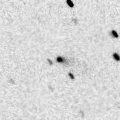
|
It brightened very rapidly. Now it is very bright visually as 11.4 mag (Sept. 17, Marco Goiato). It approaches to the earth down to 0.4 A.U., and it is observable in good condition in September and October.
Date(TT) R.A. (2000) Decl. Delta r Elong. m1 Best Time(A, h)
Sept.22 0 25.69 11 42.7 0.425 1.419 166 12.5 0:23 (180, 44)
Sept.29 0 14.91 17 39.2 0.424 1.415 164 12.4 23:39 (180, 37)
|
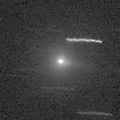
|
It brightened rapidly, and reached up to 10 mag from July to August. Now it is fading. But it is bright as 11.5 mag still now (Sept. 15, Seiichi Yoshida). It keeps observable in the morning sky after this.
Date(TT) R.A. (2000) Decl. Delta r Elong. m1 Best Time(A, h)
Sept.22 8 41.83 9 34.6 1.438 1.095 49 12.4 4:25 (246, 16)
Sept.29 9 1.96 7 12.1 1.478 1.149 50 13.1 4:14 (248, 17)
|
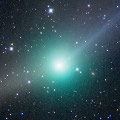
|
It kept as bright as 6-7 mag for a long time from 2011 summer to 2012 spring. Now it is appearing in the morning sky.
Date(TT) R.A. (2000) Decl. Delta r Elong. m1 Best Time(A, h)
Sept.22 9 59.97 3 51.8 4.543 3.702 29 12.5 4:25 (263, 4)
Sept.29 10 2.46 2 44.4 4.542 3.770 35 12.5 4:14 (262, 7)
|
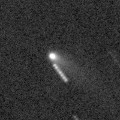
|
First return of a new periodic comet which brightened up to 14 mag in 2005. It brightened very rapidly and became much brighter than originally expected. Now it is very bright as 11.4 mag (Sept. 13, Juan Jose Gonzalez). It keeps observable in excellent condition at 11-13 mag from summer to autumn.
Date(TT) R.A. (2000) Decl. Delta r Elong. m1 Best Time(A, h)
Sept.22 2 3.06 28 25.9 0.594 1.501 138 12.8 1:59 (180, 27)
Sept.29 2 1.89 32 0.9 0.585 1.508 142 12.8 1:31 (180, 23)
|
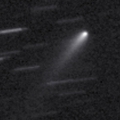
|
Now it is bright and visible visually at 12.6 mag (Sept. 16, Artyom Novichonok). It is expected to approach to the earth and to be observable at 8 mag in good condition in winter. The condition is good in the Northern Hemisphere. In the Southern Hemisphere, it will be unobservable after this. But it will become observable in good condition after 2013 January.
Date(TT) R.A. (2000) Decl. Delta r Elong. m1 Best Time(A, h)
Sept.22 14 46.94 42 26.9 1.859 1.555 56 13.3 19:20 (135,-10)
Sept.29 14 42.41 41 45.9 1.827 1.486 54 13.0 19:26 (130,-16)
|
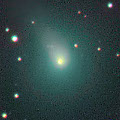
|
It brightened much faster than expected. Now it is so bright as 11.5 mag (Sept. 15, Seiichi Yoshida). In the Northern Hemisphere, it keeps observable at 11-13 mag in good condition until early 2013. In the Southern Hemisphere, it is not observable until late 2012.
Date(TT) R.A. (2000) Decl. Delta r Elong. m1 Best Time(A, h)
Sept.22 10 4.79 37 57.7 2.842 2.257 45 13.1 4:25 (235,-17)
Sept.29 10 6.95 36 15.8 2.798 2.285 49 13.2 4:14 (235,-13)
|

|
Now it is so bright as 11.2 mag (Sept. 14, Carlos Labordena). It will be unobservable in late September in the Northern Hemisphere, or in mid October in the Southern Hemisphere. But it will be observable at 12-13 mag in good condition again in 2013.
Date(TT) R.A. (2000) Decl. Delta r Elong. m1 Best Time(A, h)
Sept.22 15 16.78 -13 29.7 5.839 5.270 51 13.2 19:20 ( 94, 30)
Sept.29 15 17.05 -13 45.2 5.949 5.283 44 13.3 19:26 ( 89, 23)
|
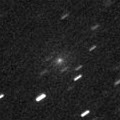
|
Now it is 15.4 mag (Aug. 11, Hidetaka Sato). However, it is extremely diffuse. The nuclear magnitude is fainter than 19 mag. Maybe the comet has been disintegrated, and will disappear soon. It keeps observable for a long time until December, but it keeps locating low in the evening after this.
Date(TT) R.A. (2000) Decl. Delta r Elong. m1 Best Time(A, h)
Sept.22 15 8.49 -2 4.1 1.738 1.300 47 13.3 19:20 (104, 22)
Sept.29 15 32.94 -5 31.3 1.739 1.296 47 13.3 19:26 ( 99, 23)
|
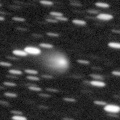
|
Now it is 13.3 mag (Sept. 13, Jakub Cerny). It keeps bright at 13-14 mag for a long time until 2014. It keeps observable for a long time in the Northern Hemisphere. It is not observable in the Southern Hemisphere.
Date(TT) R.A. (2000) Decl. Delta r Elong. m1 Best Time(A, h)
Sept.22 21 9.87 51 47.3 5.615 6.139 117 13.6 21:02 (180, 3)
Sept.29 21 2.13 50 19.3 5.617 6.126 116 13.6 20:27 (180, 5)
|
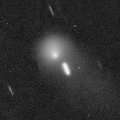
|
Now it is bright as 13.1 mag (Sept. 16, Jakub Cerny). It keeps bright as 13-14 mag for a long time after this until 2013. It is not observable in the Northern Hemisphere, but it is observable in good condition in the Southern Hemisphere.
Date(TT) R.A. (2000) Decl. Delta r Elong. m1 Best Time(A, h)
Sept.22 4 52.72 -56 16.5 5.546 5.791 99 13.8 4:25 (351, 68)
Sept.29 4 47.91 -56 45.1 5.540 5.808 100 13.8 4:14 (359, 68)
|

|
Big asteroid discovered in 1906. It suddenly showed the cometary activity on Dec. 11, 2010, probably due to an impact of a small object. Now it is 11.9 mag (May 29, Marco Goiato). It has already turned to be stellar.
Date(TT) R.A. (2000) Decl. Delta r Elong. m1 Best Time(A, h)
Sept.22 16 59.95 -30 3.5 2.519 2.507 77 14.0 19:20 ( 89, 59)
Sept.29 17 10.85 -30 26.1 2.610 2.514 73 14.1 19:26 ( 85, 54)
|
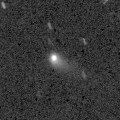
|
Now it is bright and visible visually at 13.0 mag (Sept. 13, Jakub Cerny). It keeps observable in good condition at 13-14 mag for a long time until winter. It locates somewhat low in the Southern Hemisphere.
Date(TT) R.A. (2000) Decl. Delta r Elong. m1 Best Time(A, h)
Sept.22 23 44.99 38 35.1 2.401 3.243 141 14.1 23:38 (180, 16)
Sept.29 23 43.00 37 41.2 2.367 3.229 143 14.0 23:08 (180, 17)
|

|
Now it is so bright as 12.4 mag (Aug. 17, Carlos Labordena). It will be too low to observe in the evening sky soon. But it will be observable at 12-14 mag in good condition again in 2013. However, it locates somewhat low in the Northern Hemisphere in 2013.
Date(TT) R.A. (2000) Decl. Delta r Elong. m1 Best Time(A, h)
Sept.22 14 21.66 -6 53.2 3.704 2.961 36 14.1 19:20 ( 92, 15)
Sept.29 14 31.40 -8 6.3 3.747 2.953 32 14.1 19:26 ( 88, 11)
|
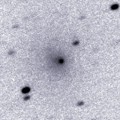
|
Now it is 13.2 mag (Sept. 2, Jakub Cerny). It is not observable already in the Northern Hemisphere. It will be unobservable soon also in the Southern Hemisphere.
Date(TT) R.A. (2000) Decl. Delta r Elong. m1 Best Time(A, h)
Sept.22 12 54.03 -14 0.6 7.181 6.248 20 14.2 19:20 ( 74, 2)
Sept.29 12 58.98 -14 30.4 7.209 6.247 15 14.3 19:26 ( 69, -4)
|

|
It kept as bright as 11-12 mag for a long time from 2011 autumn to 2012 spring. Now it is 16.1 mag (Sept. 14, A. Diepvens). It keeps observable in good condition until next spring while the comet will be fading gradually.
Date(TT) R.A. (2000) Decl. Delta r Elong. m1 Best Time(A, h)
Sept.22 9 23.08 10 6.6 3.488 2.788 39 15.3 4:25 (252, 7)
Sept.29 9 32.66 9 14.2 3.456 2.820 43 15.3 4:14 (252, 9)
|
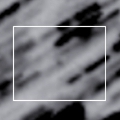
|
First return of a new periodic comet discovered in 1994. Now it is 17.2 mag (Sept. 15, J. L. Martin), somewhat fainter than expected. It is expected to brighten rapidly, to reach up to 13.5 mag, and to be observable in good condition from autumn to winter.
Date(TT) R.A. (2000) Decl. Delta r Elong. m1 Best Time(A, h)
Sept.22 19 20.19 25 14.2 0.983 1.613 108 15.6 19:20 (178, 30)
Sept.29 19 26.20 23 2.9 0.956 1.560 105 15.3 19:26 (171, 32)
|
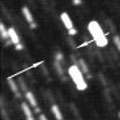
|
Now it is 14.9 mag (Sept. 14, Jakub Cerny). In the Southern Hemisphere, it will be observable at 15-16 mag in good condition for a long time until 2013 summer. It is not observable at all in the Northern Hemisphere.
Date(TT) R.A. (2000) Decl. Delta r Elong. m1 Best Time(A, h)
Sept.22 16 30.58 -80 48.9 3.825 3.902 86 15.3 19:20 ( 8, 41)
Sept.29 16 40.61 -80 42.7 3.889 3.907 83 15.4 19:26 ( 9, 41)
|
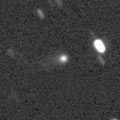
|
Now it is 15.7 mag (Sept. 8, P. Dupouy, J. B. de Vanssay)�$B!#�(BIt keeps 15-16 mag from autumn to winter. It keeps observable in good condition for a long time until the comet fades out in the Northern Hemisphere. It is not observable until 2013 summer in the Southern Hemisphere. By the way, Juan Jose Gonzalez reported it extremely bright as 10.7 mag visually on Sept. 6.
Date(TT) R.A. (2000) Decl. Delta r Elong. m1 Best Time(A, h)
Sept.22 9 54.91 66 55.8 3.777 3.560 69 16.0 4:25 (206,-29)
Sept.29 10 0.34 68 30.3 3.679 3.554 74 15.9 4:14 (204,-28)
|
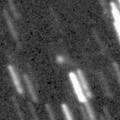
|
Now it is 16.1 mag (Sept. 15, A. Diepvens). It is expected to brighten up to 10 mag from winter to spring in 2013. In the Northern Hemisphere, it keeps observable in good condition until 2013 April. It is not observable now in the Southern Hemisphere. It will become observable after 2013 April, but it keeps locating low.
Date(TT) R.A. (2000) Decl. Delta r Elong. m1 Best Time(A, h)
Sept.22 16 41.19 89 9.4 3.126 3.273 89 16.1 19:20 (179,-34)
Sept.29 16 29.85 88 10.5 3.016 3.204 91 16.0 19:26 (178,-34)
|
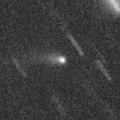
|
Now it is 15.9 mag (Sept. 13, Toshiyuki Takahashi). It will brighten up to 15 mag from autum to winter. In the Northern Hemisphere, it keeps observable for a long time until the comet fades out. It is not observable in the Southern Hemisphere, except for 2013 spring, but the comet locates extremely low only.
Date(TT) R.A. (2000) Decl. Delta r Elong. m1 Best Time(A, h)
Sept.22 13 32.21 68 19.2 2.662 2.502 69 16.1 19:20 (154,-32)
Sept.29 13 33.15 67 47.9 2.602 2.470 71 16.0 19:26 (153,-35)
|

|
This comet brightened up to 10 mag in outburst in 1995, however, it became lost after that. The condition of this apparition is bad. It was not observable around the perihelion passage. But it is appearing in the morning sky now. However, it is not detected, fainter than 19.0 mag (Sept. 16, Martin Masek).
Date(TT) R.A. (2000) Decl. Delta r Elong. m1 Best Time(A, h)
Sept.22 7 39.64 9 50.8 2.506 2.267 64 16.3 4:25 (234, 26)
Sept.29 7 48.31 9 12.4 2.477 2.320 69 16.7 4:14 (233, 28)
|
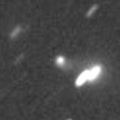
|
Jakub Cerny reported the comet brightened up to 14.5 mag in late July. Now it is 15.2 mag, a bit brighter than this ephemeris still now (Sept. 14, Jakub Cerny). It will be observable in good condition in the Southern Hemisphere while fading gradually after this. It will locate somewhat low in the Northern Hemisphere.
Date(TT) R.A. (2000) Decl. Delta r Elong. m1 Best Time(A, h)
Sept.22 22 51.21 -29 30.3 2.919 3.799 146 16.5 22:44 (180, 84)
Sept.29 22 48.57 -29 47.1 3.025 3.853 140 16.7 22:14 (180, 85)
|
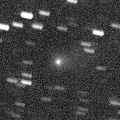
|
Now it is 16.0 mag (Sept. 14, Jakub Cerny). It tends to brighten after the perihelion passage. It keeps observable at 16-17 mag from 2012 to 2013. It locates somewhat low in the Northern Hemisphere.
Date(TT) R.A. (2000) Decl. Delta r Elong. m1 Best Time(A, h)
Sept.22 16 46.73 -22 12.6 3.270 3.142 73 16.5 19:20 ( 99, 53)
Sept.29 16 55.09 -22 40.3 3.365 3.147 68 16.6 19:26 ( 94, 48)
|
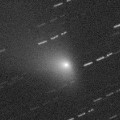
|
It approached to the sun down to 0.12 A.U. on July 14, and brightened up to 7.8 mag (July 22, Juan Jose Gonzalez). Now it is fading rapidly in the evening low sky. But it is bright as 13.5 mag still now (Sept. 12, M. Urbanik, H. Sato).
Date(TT) R.A. (2000) Decl. Delta r Elong. m1 Best Time(A, h)
Sept.22 15 42.51 -10 20.8 1.931 1.621 57 16.6 19:20 (102, 34)
Sept.29 15 57.57 -12 15.2 2.111 1.727 54 17.2 19:26 ( 97, 31)
|
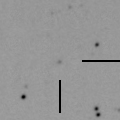
|
Jean-Francois Soulier reported that it had faded down to 19.8 mag on Sept. 16, however, it suddenly brightened up to 16.6 mag on Sept. 20. It brightened by about 3 mag in outburst. It keeps observable in excellent condition after this in the Northern Hemisphere. It locates somewhat low in the Southern Hemisphere.
Date(TT) R.A. (2000) Decl. Delta r Elong. m1 Best Time(A, h)
Sept.22 2 45.81 28 24.5 2.171 2.924 130 16.7 2:42 (180, 27)
Sept.29 2 41.32 28 28.9 2.144 2.964 137 16.9 2:10 (180, 26)
|
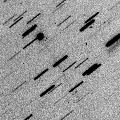
|
Looks almost asteroidal. But it has a very faint tail. It passed near by the earth, and brightened up to 13.9 mag (July 22, Artyom Novichonok). Now it is fading, but still bright as 15.9 mag (Sept. 15, A. Diepvens). It keeps observable in excellent condition in the Northern Hemisphere. It locates extremely low in the Southern Hemisphere.
Date(TT) R.A. (2000) Decl. Delta r Elong. m1 Best Time(A, h)
Sept.22 17 53.97 38 45.5 1.586 1.864 89 16.7 19:20 (162, 13)
Sept.29 17 52.74 37 54.5 1.724 1.927 85 16.9 19:26 (155, 11)
|

|
The condition of this apparition is bad, and it was not observable around the perihelion passage. Now it is 17.1 mag (Sept. 14, A. Diepvens). It will be fainter than 18 mag in late October.
Date(TT) R.A. (2000) Decl. Delta r Elong. m1 Best Time(A, h)
Sept.22 1 56.43 1 49.5 1.889 2.804 150 17.0 1:53 (180, 53)
Sept.29 1 50.42 1 22.7 1.887 2.841 157 17.1 1:19 (180, 54)
|
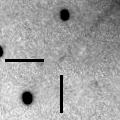
|
It was observed at 17 mag in 2011 autumn. It will be observable at 17 mag in good condition again from autumn to winter in 2012. However, no observations have been reported recently. It locates low in the Southern Hemisphere.
Date(TT) R.A. (2000) Decl. Delta r Elong. m1 Best Time(A, h)
Sept.22 6 27.98 22 44.9 2.937 2.982 82 17.1 4:25 (211, 26)
Sept.29 6 33.98 23 39.1 2.855 2.997 88 17.0 4:14 (208, 26)
|
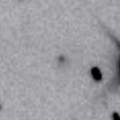
|
First return of a new periodic comet discovered in 2005. Now it is 16.6 mag (Sept. 4, Mitsunori Tsumura). It will be observable in excellent condition at 17-18 mag until November.
Date(TT) R.A. (2000) Decl. Delta r Elong. m1 Best Time(A, h)
Sept.22 23 10.40 5 8.6 1.198 2.188 167 17.2 23:03 (180, 50)
Sept.29 23 6.44 4 51.5 1.216 2.187 160 17.2 22:31 (180, 50)
|
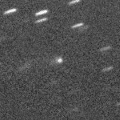
|
Now it is 17.5 mag (Sept. 13, S. Shurpakov). It keeps 17 mag for a long time from 2009 to 2013.
Date(TT) R.A. (2000) Decl. Delta r Elong. m1 Best Time(A, h)
Sept.22 22 42.11 11 16.8 7.570 8.510 158 17.2 22:35 (180, 44)
Sept.29 22 37.38 10 44.1 7.621 8.524 152 17.2 22:02 (180, 44)
|
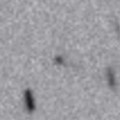
|
Although it was extremely faint as 20.0 mag on May 27 (Hidetaka Sato), it brightened rapidly. Now it is 16.6 mag (Sept. 15, F. G. Pinilla). It keeps observable in good condition at 17 mag from summer to autumn.
Date(TT) R.A. (2000) Decl. Delta r Elong. m1 Best Time(A, h)
Sept.22 23 15.02 7 9.5 1.076 2.067 167 17.2 23:07 (180, 48)
Sept.29 23 8.95 7 56.6 1.096 2.068 160 17.3 22:34 (180, 47)
|
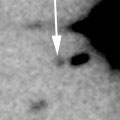
|
Now it is 17.2 mag (Sept. 11, K. Hills). In the Southern Hemisphere, it keeps observable at 17 mag in good condition for a long time from 2012 to 2013. It is not observable at all in the Northern Hemisphere.
Date(TT) R.A. (2000) Decl. Delta r Elong. m1 Best Time(A, h)
Sept.22 7 11.29 -55 23.1 5.029 4.952 79 17.5 4:25 (319, 56)
Sept.29 7 12.00 -57 31.8 4.992 4.941 81 17.4 4:14 (324, 57)
|

|
First return of a new periodic comet discovered in 1997 at 17 mag. It is expected to keep 17 mag for a long time from 2012 to 2014. The ephemeris says it is already 18 mag, but it has not been recovered yet. Toru Yusa reported that the comet was not detected, fainter than 19.5 mag, on July 18.
Date(TT) R.A. (2000) Decl. Delta r Elong. m1 Best Time(A, h)
Sept.22 2 22.11 15 12.0 3.184 4.014 140 17.6 2:18 (180, 40)
Sept.29 2 20.16 14 59.7 3.109 3.996 148 17.5 1:49 (180, 40)
|
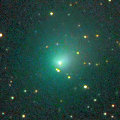
|
It brightened up to 10 mag from autumn to winter in 2011. It has already faded down to 18.5 mag (Sept. 16, Jakub Cerny). In the Southern Hemisphere, it keeps observable in good condition while fading graudlaly after this. It will be hardly observable in the Northern Hemisphere.
Date(TT) R.A. (2000) Decl. Delta r Elong. m1 Best Time(A, h)
Sept.22 5 2.99 -37 17.7 4.313 4.610 100 17.6 4:25 (290, 83)
Sept.29 5 0.03 -39 17.7 4.321 4.669 104 17.7 4:14 (327, 85)
|
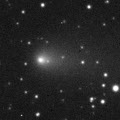
|
It brightened up to 12 mag in 2010. Now the comet is around the aphelion. But it will be observable at 17.5 mag in good condition from autumn to winter.
Date(TT) R.A. (2000) Decl. Delta r Elong. m1 Best Time(A, h)
Sept.22 4 44.73 20 45.2 4.165 4.558 106 17.8 4:25 (184, 34)
Sept.29 4 44.71 20 50.1 4.072 4.567 113 17.8 4:13 (180, 34)
|
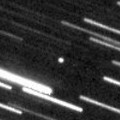
|
In the Northern Hemisphere, it will be observable at 17.5 mag in excellent condition in October and November. It locates low in the Southern Hemisphere.
Date(TT) R.A. (2000) Decl. Delta r Elong. m1 Best Time(A, h)
Sept.22 3 53.11 44 31.3 1.475 2.064 111 17.9 3:50 (180, 10)
Sept.29 3 40.82 45 4.2 1.426 2.104 119 17.8 3:10 (180, 10)
|
|
![]()
 C/2011 A3 ( Gibbs )
C/2011 A3 ( Gibbs ) 152P/Helin-Lawrence
152P/Helin-Lawrence 96P/Machholz 1
96P/Machholz 1 37P/Forbes
37P/Forbes P/2012 NJ ( La Sagra )
P/2012 NJ ( La Sagra ) 71P/Clark
71P/Clark P/2011 N1 ( ASH )
P/2011 N1 ( ASH ) 261P/2012 K4 ( Larson )
261P/2012 K4 ( Larson ) C/2008 S3 ( Boattini )
C/2008 S3 ( Boattini ) 160P/LINEAR
160P/LINEAR C/2012 C1 ( McNaught )
C/2012 C1 ( McNaught ) P/1997 C1 ( Gehrels )
P/1997 C1 ( Gehrels ) C/2010 G2 ( Hill )
C/2010 G2 ( Hill ) 65P/Gunn
65P/Gunn (3200) Phaethon
(3200) Phaethon![]()




































